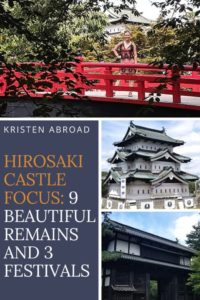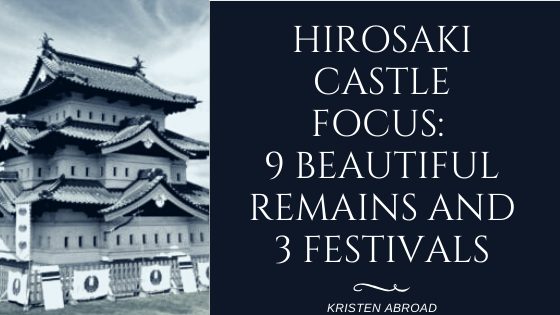Don’t leave Japan without first seeing a Japanese castle, you won’t see these in other parts of the world. What I believe people identify with is the 天主 (tenshu, or keep), which is the highest tower in the castle complex. There’s only twelve original remaining and Hirosaki Castle is one of them.
- Hirosaki Castle Main Keep and it’s crazy history
- Important Cultural Properties of Hirosaki Castle
- Speaking of disaster: Moving Hirosaki Castle
- Take a picture at 下乗橋 (ゲジョウバシ, Gejo Bridge)
- Botanical Gardens, Shinto Shrine, and other features
- Festivals at Hirosaki Castle Park
- How to get to Hirosaki Castle
- Sharing is caring. Pin this for later.
[Editor’s Note: This post was originally published in August of 2018 and has been updated for freshness, accuracy, and comprehensiveness.]
Hirosaki Castle Main Keep and it’s crazy history
Constructed in 1611, Hirosaki Castle’s
Its full five
Which they did, obviously.
The three-story tenshu you see today was finished in 1810. It wasn’t put back where the original was housed but moved to the seaward facing side. Luckily, that still puts it in the Edo period which ended in 1868, and therefore Hirosaki Castle can be considered one of the 12 pre-Meiji era constructed castles still in existence.
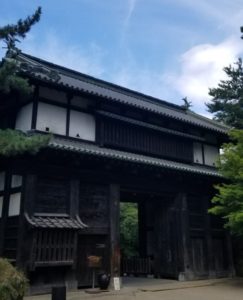
This gate, Ninomaru South Gate, on the other hand, is thought to be original.
Important Cultural Properties of Hirosaki Castle
The Agency for Cultural Affairs has designated 9 structures at Hirosaki Castle as Important Cultural Property (重要文化財 jūyō bunkazai). These are all structures remaining from Edo period.
- 北の郭北門(亀甲門) Kitanokuruwa Kitamon (Kamekoumon)
- 二の丸東門 Ninomaru Higashimon
- 二の丸南門 Ninomaru Nanmon
- 二の丸未申櫓Ninomaru Hitsujisaru Yagura
- 二の丸辰巳櫓Ninomaru Tatsumi Yagura
- 二の丸丑寅櫓Ninomaru Ushitora Yagura
- 三の丸東門 Sannomaru Higashimon
- 三の丸追手門Sannomaru Otemon
- 天守 Tenshu
I go more into depth on different castle characteristics in the post about the 200 famous castles in Japan, but to summarize, ninomaru and sannomaru are the second and third baileys.
門 or “mon” means gate (can you see it a little bit with the kanji? It looks like a midwest saloon door to me) and 櫓 or “yagura” means watchtower. 天守 or “tenshu” is the main castle tower or keep and probably what most people think when they think about Japanese castles.
But why only have one designation? Hirosaki Castle is also combined as a National Historic Site with its fellow Tsugaru Clan Castle sites of Tanesato Castle and Horikoshi Castle. Both were much older and thanks to the Tokugawa Shogunate’s direction that each daimyo (Japanese Feudal Lord) could only have one castle (poor things!) were destroyed in the early 1600s.
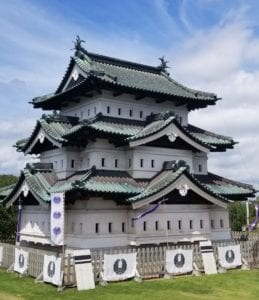
Speaking of disaster: Moving Hirosaki Castle
In 1983, there was a great earthquake in the Sea of Japan. Hirosaki is close to the water… it’s an island, it’s all close. Anyway, thank you Mr. Earthquake, you damaged a perfectly good 400-year-old wall beneath the castle. Funnily enough, they use the word “はらみ”, for it which can mean “pregnant”.
This threatens to collapse the whole thing if another earthquake should hit, as a result, they MOVED it. Ceremoniously, they had people help with part of the movement (think giant tug of war against a building), the rest they did with machines. Though I don’t think the castle would complain, it has an even better view of Mt. Iwaki, the stratovolcano, in the distance now. Construction is expected to finish in 2023, which impacts your view but also cool to see the work being done.
Take a picture at 下乗橋 (ゲジョウバシ, Gejo Bridge)
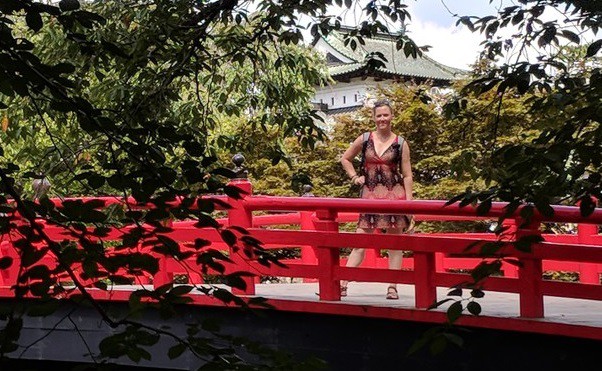
The bridge leading to Hirosaki Castle crosses the moat between the main and second baileys is called 下乗橋 (ゲジョウバシ, Gejobashi – Google doesn’t translate that correctly, by the way). It was meant to knock down when invading armies came. Therefore, it is not original but makes a beautiful picture spot!
The name is thought to come from the requirement to dismount your horse before going across the bridge and there is a plaque that talks about it.
Don’t stop there though, there are 9 bridges in total within the park!
Disclosure: Kristenabroad.com is a participant in the Amazon Services LLC Associates Program and other affiliate programs. For some links to products or services in this article, I may earn a small commission by you using my link. The price for you is not affected.
Botanical Gardens, Shinto Shrine, and other features
There are also botanical gardens to check out on the property that you can get a joint ticket for with Hirosaki Castle. There is also a Shinto shrine you can visit.
Scattered throughout the property are remains of storehouses, missing gates and turrets, plus the foundation for the original castle tower. Sadly as is with the majority of palaces or 御殿 (goten), all that remains is a marker for where it once stood.
You’re going to get your exercise for the day visiting as the park is massive! By the way, if you are ever looking for an awesome fitness watch, I highly recommend the Garmin Fenix 5S and since they came out with series 6 it is less expensive!
Festivals at Hirosaki Castle Park
There are three events to keep in mind throughout the year that take place in the castle park.
弘前さくらまつり・Hirosaki Sakura Festival
The Hirosaki Sakura (Cherry Blossom) Festival takes place for a few weeks between the end of April and beginning of May. That pushes it into Golden Week so I would recommend earlier if you want to avoid crowds. It is also a good idea to check when the peak bloom is supposed to be!
The castle park boasts some 2600 cherry blossom trees (their count, not mine – check out the logo, 2600 trees, and 400 years of history) and is said to be one of the best in Japan!
Most impressive is what they call the “flower raft” which is a coating of pedals on the surface of the moat.
弘前城雪燈籠まつり・Hirosaki Castle Snow Lantern Festival
The Hirosaki Castle Snow Lantern Festival (弘前城雪燈籠まつり) has taken place in early February every year since 1977. There are giant snow statues, projection mapping, and snow lanterns plus a really cool looking light-up art installation.
Just like Hokkaido has many snow festivals, Tohoku has a bunch as well. Five large ones to be exact. They are referred to as the みちのく五大雪まつり, best part? They all happen around the same time. One of these years I’m going to do them all in the same go!
冬に咲くさくらライトアップ・ Winter Sakura Bloom Light Up
Can’t make it for the snow festival? Japan loves its winter illuminations and Hirosaki is no different! From December through February what started as one picture in 2016 has turned into a yearly event called 冬に咲くさくらライトアップ or Winter Sakura Bloom Light Up.
How to get to Hirosaki Castle
Aomori Prefecture is absolutely gorgeous and you can definitely make a weekend trip out of it with the fastest shinkansen route in Japan.
From Tokyo to Hirosaki Castle is a relatively easy route. Take the Hayabusa Shinkansen from Tokyo Shinkansen platform bound for Shin-Aomori Station. Switching at Shin-Aomori Station you get on the JR Ou Line or you can take the Limited Express Tsugaru to Hirosaki Station.
You could also take a plane but by the time you add in time to get through security and waiting at the airport, taking the train ends up being similar time-wise. Plus, if you are using the JR Rail Pass, this route definitely gets you your money’s worth.
From there, the castle isn’t that far of a walk from the Hirosaki train station or they have the “loop bus” route if the weather is bad for 100 yen. Those buses come much more regularly (10 min) than the ones I mentioned to get to Takayama Inari Shrine! (The sign for the hundred yen bus is hilarious, look out for it).
Sharing is caring. Pin this for later.
